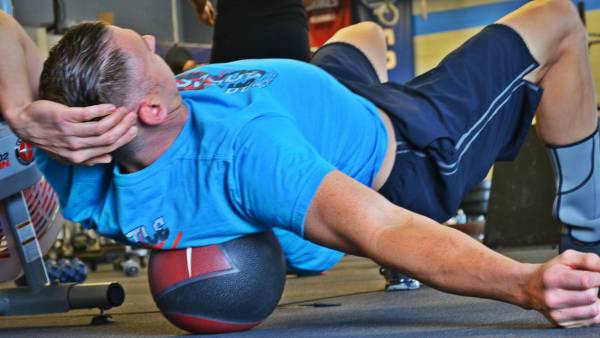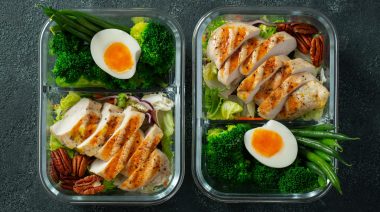A freak accident or momentary lapse in concentration during intense training is all it takes for injuries to happen. Some injuries could stall your progress for months and even require surgery. If you’re a serious gym rat, that kind of setback is your worst nightmare.
Modern orthopedic procedures are more effective than ever, but most surgeons neglect to provide guidance in the post-operative phase, besides taking painkillers as needed. This approach misses out on a critical opportunity to educate patients on optimal nutrition to speed the recovery process. While painkillers like Percocet and Vicodin are valuable in the initial stages of recovery, they don’t actually heal the body, and are in fact fairly harsh on the liver and gut.
Below are some of the strategies and supplements I have researched and used when recovering from my pectoral repair surgery, in addition to other less serious injuries. Although these have a good track record of being safe and effective, it is always important to speak with your surgeon before taking supplements in the days immediately before or after surgery, as certain nutrients can interfere with pain medications or blood clotting.
Foods rich in omega-3 fatty acids, like wild-caught salmon, help fight inflammation.
6 Ways to Help Your Body Heal Post Surgery: 1. Anti-Inflammatory Diet
In the post-operative phase, steer clear of inflammatory foods like processed products, preservative-laden foods, wheat flour and other gluten-containing foods, excessive sugar, trans fats, excessive omega-6 oils like canola, soybean, and corn oils.
Focus on foods that mitigate inflammation. Foods that are high in omega-3 fatty acids, like mackerel, pastured eggs, wild salmon, and grass-fed meats, will help to reduce inflammation. If you don’t have access to all these foods, take a fish oil supplement to fill in the gaps. Pineapple and papaya contain bromelain and papain, which are both helpful anti-inflammatory enzymes. And it goes without saying that staying well hydrated and eating a balanced diet are both important.
During the first day or two after surgery when you are recovering at home and might still be on painkillers, you probably will not have much of a desire to eat healthy foods, or even to eat. Many people including myself, tend to get severe nausea from opioid-based painkillers. Just remember that the sooner you can provide your body with quality nutrition, the faster you will be on the road to recovery. The last thing you want to do is delay healing by snacking on junk food during this crucial window of time.
6 Ways to Help Your Body Heal Post Surgery: 2. High-Protein Diet
In the first few weeks after a serious injury or surgical procedure, your body will be working in overdrive to repair its damaged tissues. Having a steady supply of amino acids during this time is essential for the healing process. It also limits muscular atrophy that can occur during your downtime away from training.
Aim to get at least one gram of protein per pound of body weight. I prefer sticking to whole proteins from animal and plant sources, but supplemental protein powders may be used if you find yourself having trouble eating enough. If you use protein powders, look for a plant-based protein blend or a goat milk-based whey protein for ease of digestion.
6 Ways to Help Your Body Heal Post Surgery: 3. Proteolytic Enzymes
The use of systemic, proteolytic enzymes is still a somewhat controversial topic within the medical community and is seen as an “alternative” treatment. I recommend them based on the positive results demonstrated in scientific studies, the safety of using enzymes as compared to NSAIDs and opioid-based painkillers, and my own personal experience with them after surgery.
When most people think of supplemental enzymes, they probably assume they are being used as a digestive aid, but that is only one use. When these enzymes are taken on an empty stomach, they can be absorbed into the bloodstream where they break down inflammatory proteins throughout the entire body (hence the term “systemic enzymes”). They also help the body dissolve excess scar tissue. The use of enzymes post surgery has been proven effective in significantly reducing swelling and pain,1,2 and has been shown to be a viable replacement to traditional NSAIDs based on its efficacy3 and gentle effect on the body.
There are many different enzyme formulas out there. Most of the quality brands contain enzymes like pancreatin, papain, bromelain, trypsin, chymotrypsin, lipase, amylase, and superoxide dismutase. Wobenzym by Garden of Life and Intenzyme Forte by Biotics are two good choices. The enzyme formulas from high-quality brands can be expensive, but the cost is well worth it. If I had to choose only one post-surgery supplement, it would be a good quality enzyme formula. Remember that in order to get the most use out of the enzymes, you want to take them on an empty stomach in between meals.
6 Ways to Help Your Body Heal Post Surgery: 4. Probiotics
It is common to receive intravenous antibiotics before surgical procedures in order to prevent infection. The unfortunate side effect of these antibiotics is that they can also kill the beneficial bacteria in the gut, as well as promote antibiotic-resistant strains of bacteria. Although the functions of beneficial bacteria and yeast are still being researched, we know they are important for maintaining a strong immune system, good digestion, and proper nutrient absorption, all of which are important in facilitating your recovery.
Probiotics, which are the beneficial forms of bacteria and yeast, can be obtained from food sources as well as supplements. Fermented foods and drinks such as kimchi, sauerkraut, kombucha, fermented pickles, kefir, and yogurt are all probiotic powerhouses. Just make sure they were produced in a way that preserves the live cultures of bacteria in order to receive the full benefit. Alternatively, if you want to save some money and get creative, there are a ton of great resources online that teach how to make your own fermented foods at home. The bacterial strains found in these foods tend to be more diverse than those you get from supplements.
The benefit of buying probiotics in supplement form is the increased degree of precision and convenience in your dosing. Before and after being administered antibiotics, I recommend taking Saccharomyces boulardii, a probiotic yeast that will survive the antibiotics and is helpful in eliminating intestinal pathogens and preventing diarrhea. Additionally, a broad-spectrum probiotic from a reputable supplement brand (Jarrow, Designs for Health, Pure Encapsulations, and Garden of Life are a few of the companies that I like to use) should be taken for at least a couple weeks after the administration of antibiotics.

Use nutrition alongside other physical practices like rehab to speed your recovery.
6 Ways to Help Your Body Heal Post Surgery: 5. Curcumin
Curcumin is a naturally occurring chemical found in turmeric root. It is currently one of the most studied natural supplements and has been shown to have anti-inflammatory, antimicrobial, and even anticarcinogenic benefits. It has also been shown to significantly decrease pain after surgery.4,5,6 When I used curcumin as part of my post-surgery supplement stack, I only had to use the prescribed painkillers for the first a day-and-a-half after the surgery, even though the doctors had prescribed a month’s worth of painkillers.
When choosing a curcumin supplement, make sure to buy a formula that includes piperine (black pepper extract), which has been shown to greatly increase the bioavailability of curcumin. You don’t have to worry about harsh side-effects when taking curcumin, so dosing at least three times per day should help you to manage the pain and phase out the painkillers.
6 Ways to Help Your Body Heal Post Surgery: 6. Glutamine
Glutamine is an amino acid that is utilized in many different metabolic reactions in the body. While not technically an essential amino acid, glutamine becomes conditionally essential during cases of acute trauma or stress. Glutamine is one of the best bang-for-your-buck supplements when used at the appropriate times. It has been shown to be effective in reducing the length of hospital stays with surgical patients and in supporting the immune system, which in turn helps to reduce the risk of infection.7,8
Glutamine is also the primary fuel for dividing epithelial cells in the small intestine9 and maintaining or even improving intestinal integrity. This is relevant to the recovery process, because a healthy intestinal barrier improves nutrient absorption and prevents unwanted particles from getting into the bloodstream (i.e., leaky gut syndrome). Depending on your size, 20-40 grams spread throughout the day should be an effective dose.
Take a Proactive Approach to Recovery
This is far from a comprehensive list of the potentially beneficial foods and supplements that you can take to help recover faster from surgery, but in my opinion, these are the ones that make a noticeable difference and are the best value for the money. These supplements and strategies are also useful for recovering from acute injuries that don’t require surgical repair.
Providing your body with optimal nutrition through whole foods and supplements will reduce your pain and reliance on painkillers, accelerate your healing time, and get you back to 100 percent much faster than you would if you were to be rely on painkillers alone. If you are reading this because you recently got injured, keep your head up and get to work on your recovery.
More Ways to Help You Get on the Mend:
- The Mental Side of Injury: How to Adapt and Overcome
- How to Be Unstoppable in Spite of Injury
- The Science of Anti-Inflammatory Nutrition: Dissecting the Zone Diet
- New on Breaking Muscle Today
References:
1. Kamenícek V, Holán P, Fran?k P, “Systemic enzyme therapy in the treatment and prevention of posttraumatic and postoperative swelling,” Acta Chir Orthop Traumatol Cech, 68(2001):45-9.
2. Isaeva AV, Minaev SV, Sternin IuI, Minaeva NV, “Modern approach to the rehabilitation of children with fractured long tubular bones,” Vopr Kurortol Fizioter Lech Fiz Kult 3(2009):29-31.
3. Bolten WW, Glade MJ, Raum S, Ritz BW, “The safety and efficacy of an enzyme combination in managing knee osteoarthritis pain in adults: a randomized, double-blind, placebo-controlled trial,” Arthritis, (2015). Online first. doi: 10.1155/2015/251521.
4. Agarwal KA, Tripathi CD, Agarwal BB, Saluja S, “Efficacy of turmeric (curcumin) in pain and postoperative fatigue after laparoscopic cholecystectomy: a double-blind, randomized placebo-controlled study,” Surg Endosc. 25(2011):3805-10.
5. Sahbaie P, Sun Y, Liang DY, Shi XY, Clark JD, “Curcumin treatment attenuates pain and enhances functional recovery after incision,” Anesth Analg, 118(2014):1336-44.
6. Sahebkar A, Henrotin Y, “Analgesic Efficacy and Safety of Curcuminoids in Clinical Practice: A Systematic Review and Meta-Analysis of Randomized Controlled Trials,” Pain Med, 2015. Epub ahead of print.
7. Bart J. Morlion et al., “Total Parenteral Nutrition with Glutamine Dipeptide after abdominal surgery,” Annals of Surgery, 227(1998):302-308
8. Wilmore DW, “The effect of glutamine supplementation in patients following elective surgery and accidental injury,” J Nutr. 131(2001):2543S-9S.
9. Blachier, Francois et al., “Metabolism and functions of L-glutamine in the epithelial cells of the small and large intestines,” The American Journal of Clinical Nutrition, 90(2009):8145-8215.
Photo 1 courtesy of Shutterstock.
Photo 2 courtesy of Precision CrossFit.






